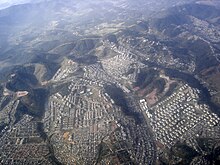
Back Pendeldorp Afrikaans بلدة تابعة Arabic Ciudá dormitoriu AST নিত্যযাত্রী শহর Bengali/Bangla Ciutat dormitori Catalan Sídlištní noclehárna Czech Ыйхă районĕ CV Soveby Danish Trabantenstadt German Dormurbo Esperanto
This article has multiple issues. Please help improve it or discuss these issues on the talk page. (Learn how and when to remove these messages)
|



A commuter town is a populated area that is primarily residential rather than commercial or industrial. Routine travel from home to work and back is called commuting, which is where the term comes from. A commuter town may be called by many other terms: "bedroom community" (Canada and northeastern US),[citation needed] "bedroom town", "bedroom suburb" (US), "dormitory town" (UK). The term "exurb" was used from the 1950s, but since 2006, is generally used for areas beyond suburbs and specifically less densely built than the suburbs to which the exurbs' residents commute.[2]
- ^ "Mobilidade: paulistano leva uma hora e meia para ir e voltar do trabalho". Cidade de São Paulo (in Portuguese). Retrieved 4 December 2021.
- ^ Berube, Alan (2006). Finding Exurbia: America's Fast-Growing Communities at the Metropolitan Fringe (PDF). Brookings Institution. Archived (PDF) from the original on 4 February 2017. Retrieved 26 June 2019.